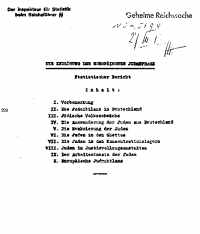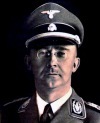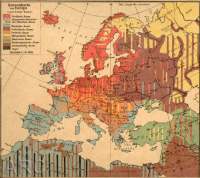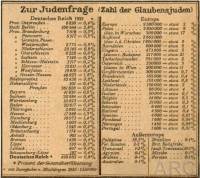 |
 |
 |
 |
 |
 |
| English German |
Himmler was thus faced with a dilemma, for on the one hand he wished to provide evidence of his achievements to Hitler, yet on the other he needed to couch those achievements in a manner discrete enough to camouflage the slaughter. Korherr's credentials for this task were unimpeachable, since he was a professional statistician, had only been a Nazi party member since 1937 and was not a member of the SS.
 |
| Himmler |
Himmler wrote to Ernst Kaltenbrunner, head of the Sipo-SD:
"I regard the report as general purpose material for later use and extremely good as camouflage. At present it must neither be published nor communicated to anyone. I shall continue to be informed through the short monthly reports of the RSHA how many go and how many remain behind."
Most of Korherr's statistics came from the RSHA, and specifically from Eichmann's office. Although he did not at first mention Korherr by name, during his interrogation in Israeli captivity Eichmann recalled discussions with a statistician about camps and how many Jews had been killed by Odilo Globocnik in the Generalgouvernement, as well as the number of Jews killed by the Einsatzgruppen. Korherr also consulted with the WVHA about registered Jewish inmates in Auschwitz, Majdanek and other camps.
During his trial in Jerusalem, Eichmann stated that he had subsequently used the report in planning the extermination programme. Information on the number of Jews enabled determination of the size of the team needed to organize liquidations in a particular place or country, the number of railroad cars required, and the camp to which the victims were to be deported.
The report is careful to distinguish between emigration and what it terms as "evacuation", another code word for deportation prior to mass murder. In the prosaic language of the statistician, Korherr reports:
"The evacuation of the Jews replaced the emigration of the Jews, at least on the territory of the Reich. It was extensively prepared since the prohibition of Jewish emigration in the autumn of 1941 and to a large extent carried out throughout the Reich territory in the year 1942. In the balance of Jewry it is referred to as 'off-going'." Details of these "evacuations" then follow.
 |
| Nazi Race Map #1 |
 |
| Nazi Race Map #2 |
Even more telling are Korherr's statistics for the Generalgouvernement and the former Soviet territories occupied by Germany. 1,274,166 Jews are described as having been "sifted" through the camps of the Generalgouvernement. This figure is of particular interest, since it precisely coincides with the total of Jews transported to the Aktion Reinhard camps as disclosed by the recently discovered Höfle Telegramme. This would undoubtedly have been Korherr's source for this data. The report also mentions 145,301 Jews as having been "sifted" through the camps of the Warthegau (principally Chelmno and, according to the RSHA statistics, the "evacuation" of 633,300 Jews from the occupied Soviet territories, including the Baltic countries, since the beginning of the Eastern Campaign (principally victims of the Einsatzgruppen).
As the latter figure did not include a full accounting of the deaths of Soviet Russian Jews in the occupied Eastern territories, nor any assessment of deaths in the rest of European Russia and at the front, it may be regarded as an underestimate. Excluding inmates of ghettos and concentration camps, a total of 2.5 million Jews had been "evacuated". This figure took no account of the excessive mortality rate in the ghettos and labour camps, nor of shootings outside of the occupied Soviet territories. Korherr concluded his initial report by stating that in the decade since the Nazis came to power, either through forced emigration or extermination, European Jewry had lost almost half its number – something in excess of 4 million people.
After the war Korherr attempted to diminish the importance of the report that bore his name. As a potential witness or defendant in court proceedings, he claimed that the data in his report were false because of inflated claims contained in the Einsatzgruppen reports. He also claimed that he did not understand the figures in his report, nor did he realize that the Einsatzgruppen killed people.
Korherr had been employed by the West German Ministry of Finance, but was dismissed from this post in 1961 following the publication of Gerald Reitlinger's book "The Final Solution", in which the Korherr Report featured prominently.
The significance of the Korherr report lies as much in the irrefutable evidence it contains of the Nazi's genocidal policies as in its wealth of statistics. Whether or not, as Korherr alleged, the Einsatzgruppen did overstate the number of their victims (and as already indicated, the number killed by the Einsatzgruppen as contained in the report is clearly understated), the Korherr Report abundantly demonstrates a concerted, continent-wide strategy of government sponsored annihilation. As such, it remains a pivotal document for our understanding of the Holocaust.
Sources:
Hilberg, Raul. The Destruction of the European Jews, Yale University Press, New Haven, 2003
Gutman, Israel, ed. Encyclopedia of the Holocaust, Macmillan Publishing Company, New York, 1990
Reitlinger, Gerald. The Final Solution – The Attempt to Exterminate the Jews of Europe 1939-1945, Jason Aronson Inc, Northvale, New Jersey and London, 1987
© ARC 2005